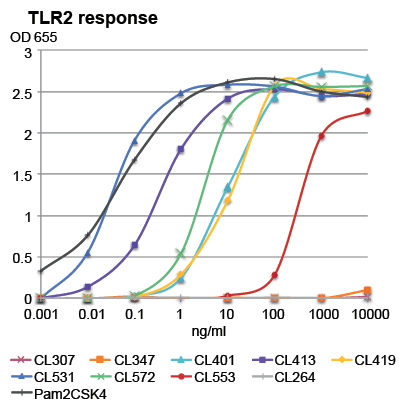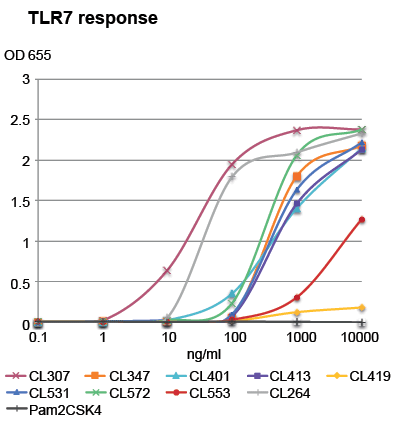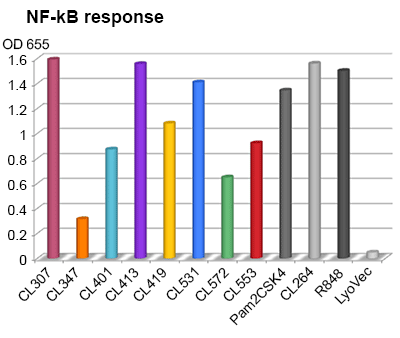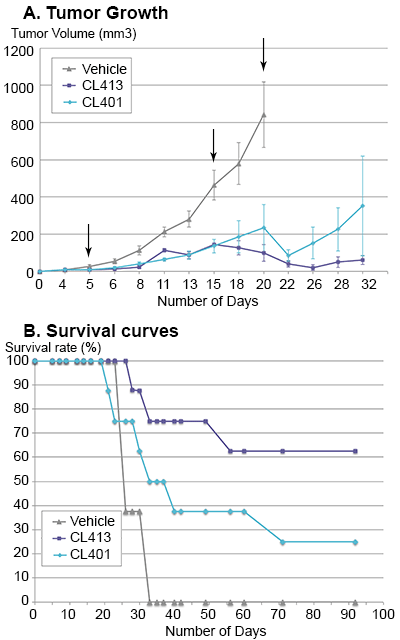Adilipoline™ (CL413)
-
Cat.code:
tlrl-c413
- Documents
ABOUT
Bispecific TLR2 & TLR7 ligand
Adilipoline™ (S-(2,3-bis(palmitoyloxy)- (2RS)propyl)- (R)-cysteinyl-(S)-seryl-(S)- lysyl- (S)-lysyl- (S)-lysyl- (S)-lysyl 4 -((6-amino-2- (butylamino)-8- hydroxy-9H- purin-9-yl) methyl) aniline) was generated by conjugation of an 8-hydroxyadenine moiety to the terminal acid function of Pam2CSK4, a TLR2 agonist.
Adilipoline™ is a good ligand for both TLR2 and TLR7. In vivo tumor studies have demonstrated that Adilipoline™ is a potent antitumor agent. Intratumoral injection of Adilipoline™ in established B16 tumors resulted in tumor regression.
All products are for research use only, and not for human or veterinary use.
SPECIFICATIONS
Specifications
C81H145N17O12S
50 pg- 10 µg/ml (~30 pM - 10 µM)
H2O (1 mg/ml)
Activation of TLR2 and TLR7 in cellular assays
Each lot is functionally tested and validated
CONTENTS
Contents
-
Product:Adilipoline™ (CL413)
-
Cat code:tlrl-c413
-
Quantity:500 µg
1.5 ml of endotoxin-free water
Shipping & Storage
- Shipping method: Room temperature
- 4°C
- Avoid repeated freeze-thaw cycles
- Do not store in plastic tubes
Storage:
Caution:
Details

HEK-Blue™ hTLR2 cells which stably express an NF-κB-inducible SEAP reporter gene and human TLR2 were incubated in HEK-Blue™ Detection (a SEAP detection growth medium) and stimulated with increasing concentrations of the agonists indicated in the graph.
After 24h incubation, the levels of NF-κB-induced SEAP were determined by reading the OD at 655 nm.

HEK-Blue™ hTLR7 cells, which stably express an NF-κB-inducible SEAP reporter gene and human TLR7 were incubated in HEK-Blue™ Detection (a SEAP detection growth medium) and stimulated with increasing concentrations of the agonists indicated in the graph.
After 24h incubation, the levels of NF-κB-induced SEAP were determined by reading the OD at 655 nm.

RAW-Blue™ cells, which stably express an NF-κB-inducible SEAP reporter gene, were stimulated with 0.6 µg/ml of InvivoGen’s multi-PRR ligands complexed with 0.1 µg/ml HSV-60 (synthetic dsDNA).
After 24h incubation, the levels of NF-κB-induced SEAP were determined using QUANTI-Blue™, a SEAP detection reagent.

(A) Tumor growth after CL413 or CL401 treatment. C57BL/6 mice were inoculated subcutaneously with 5x10e5 B16-F1 mouse melanoma cells. After seven days, Adilipoline™ (CL413), CL401 or vehicle were injected intratumorally (50 µg/mouse/50 µl) on days 5, 15 and 20. (B) Survival curves for untreated as well as CL413- or CL401-treated mice.
Each group contained 8 mice. Black arrows represent the days of injection. Tumor growth was monitored and measured with calipers after day 5 of grafting tumor cells into mice and then every 2 days thereafter. Tumor volume in mm3 was determined according to the formula V = W2 x L/2, where L = length (mm) and W = width (mm).
DOCUMENTS
Documents
Technical Data Sheet
Safety Data Sheet
Certificate of analysis
Need a CoA ?


